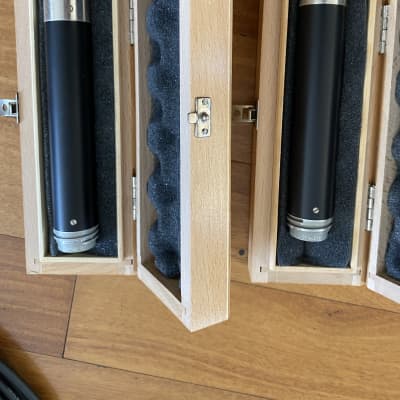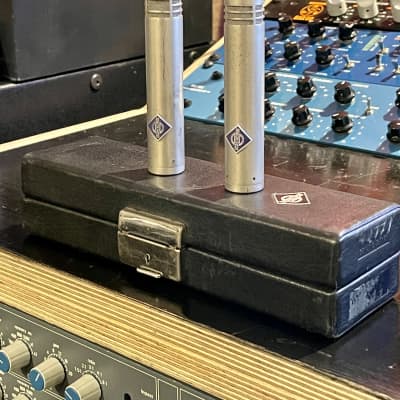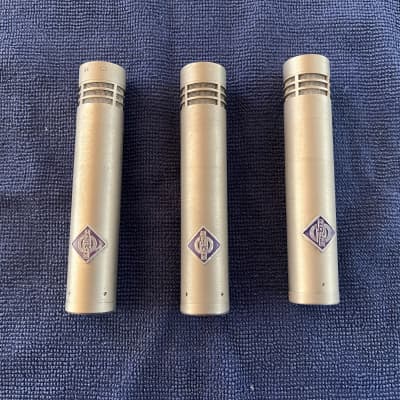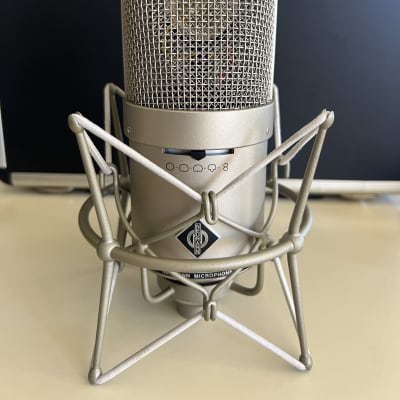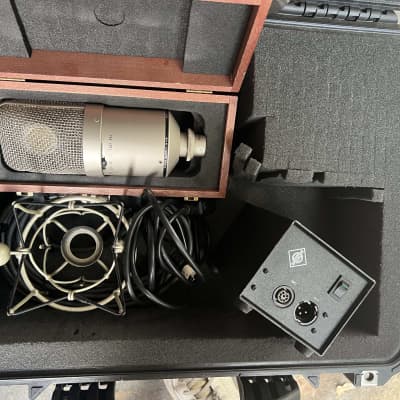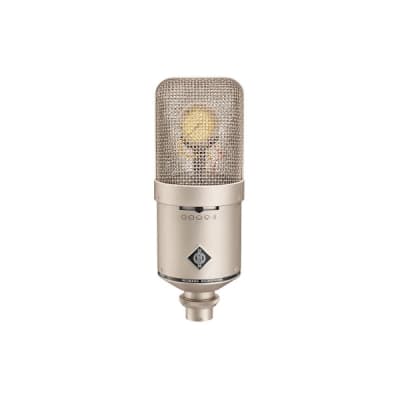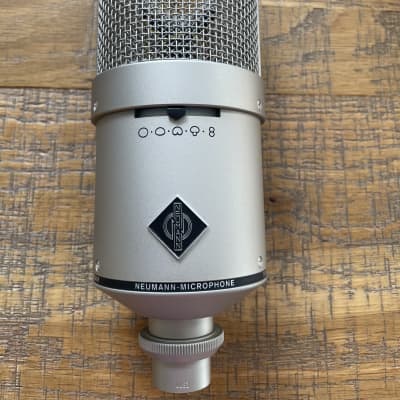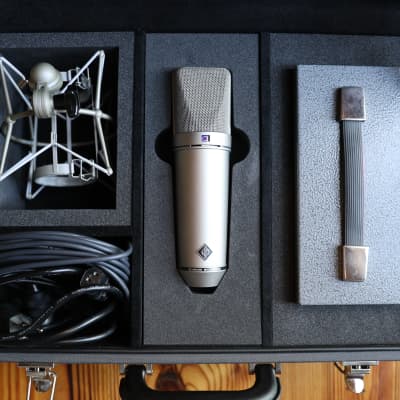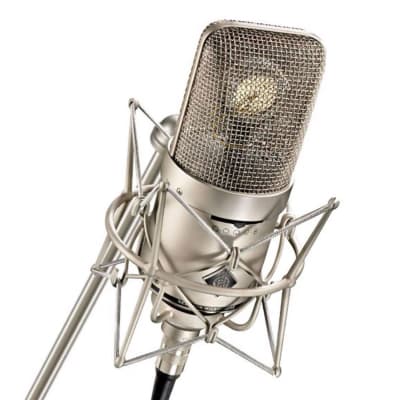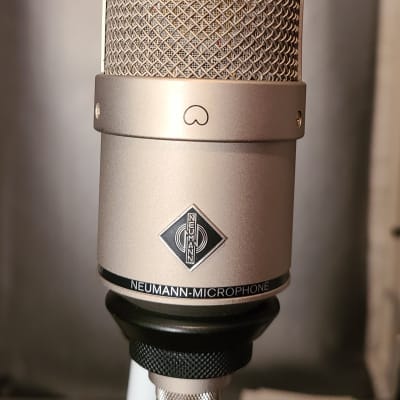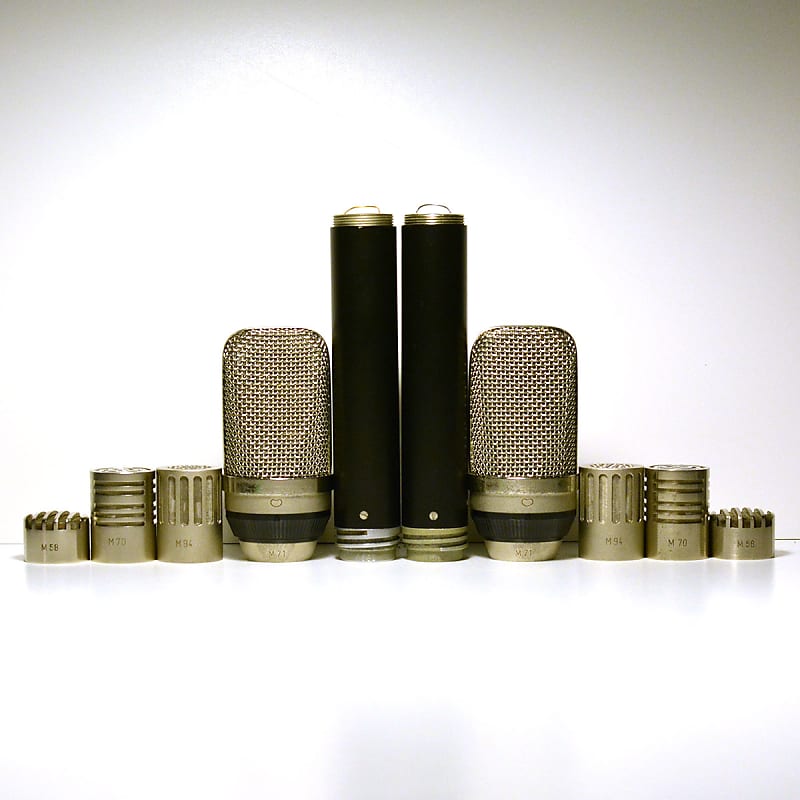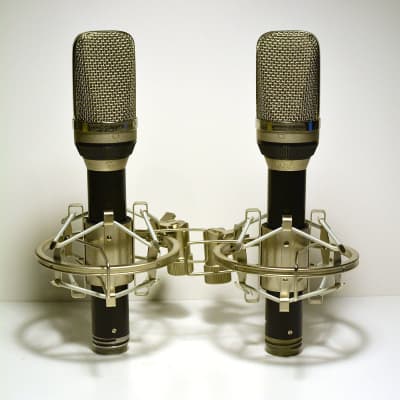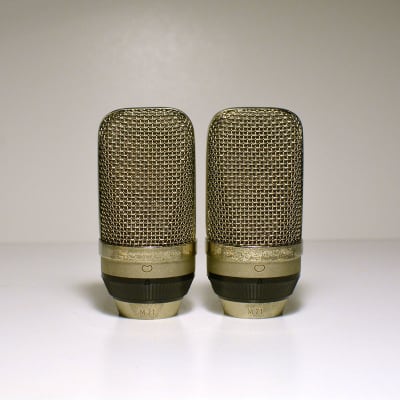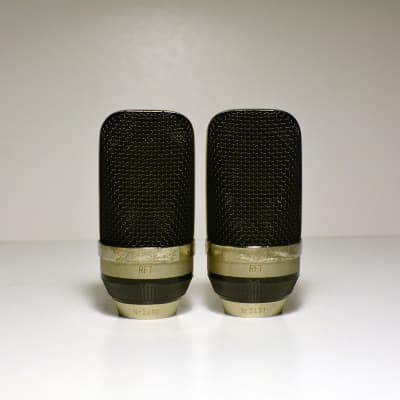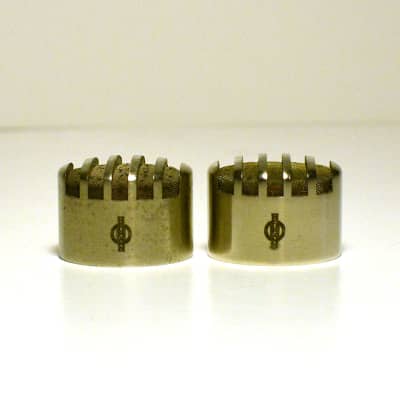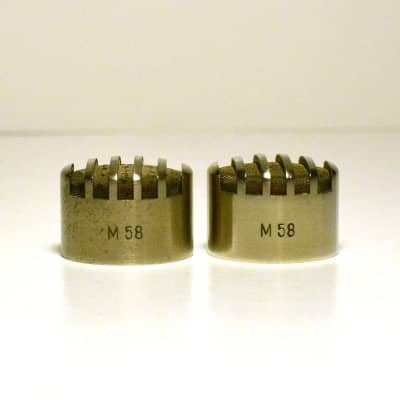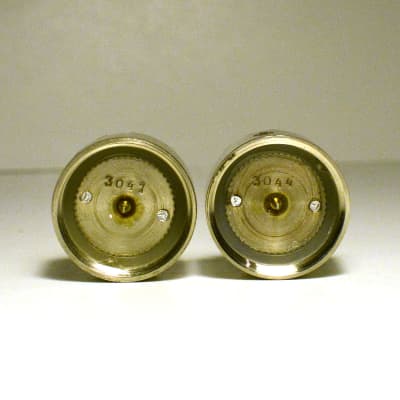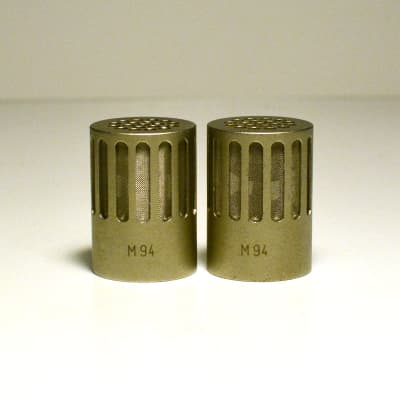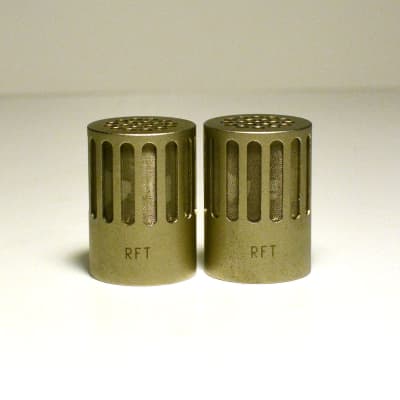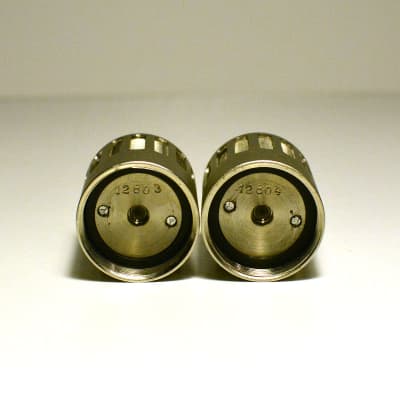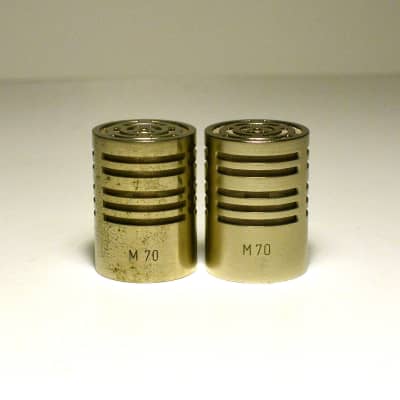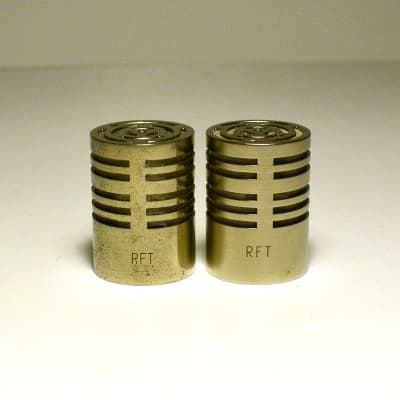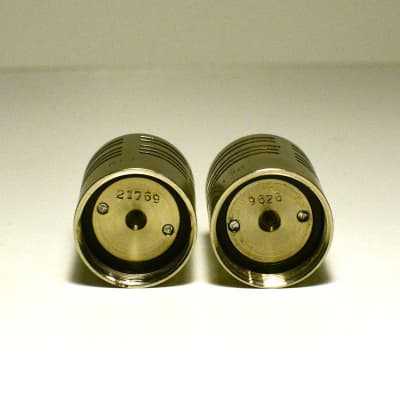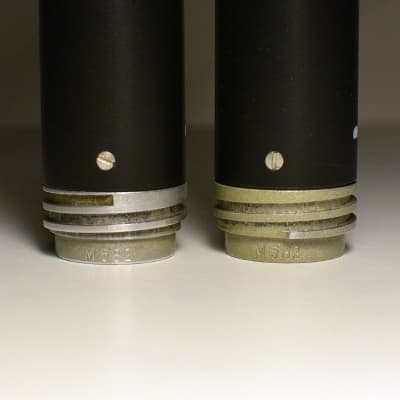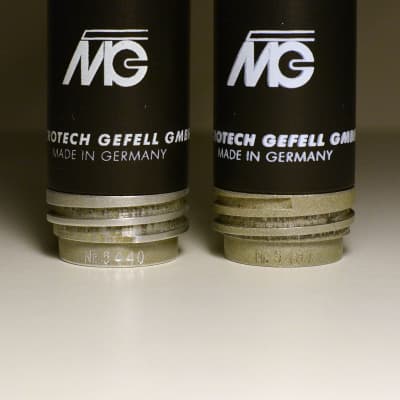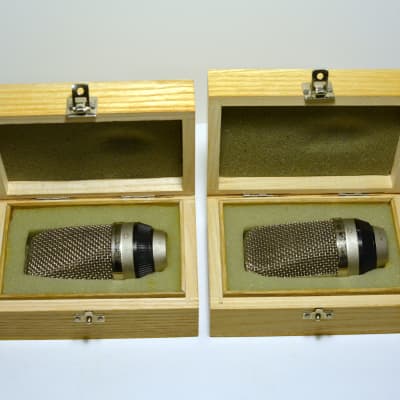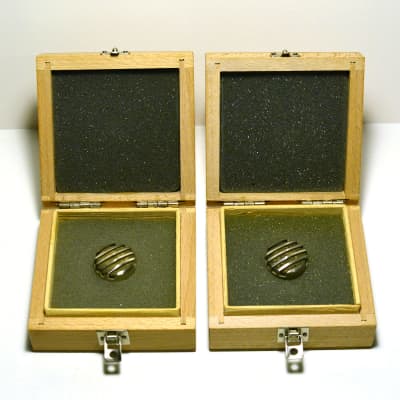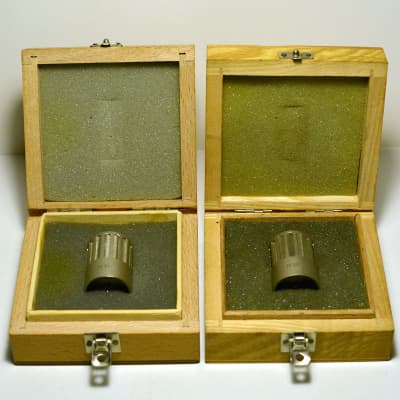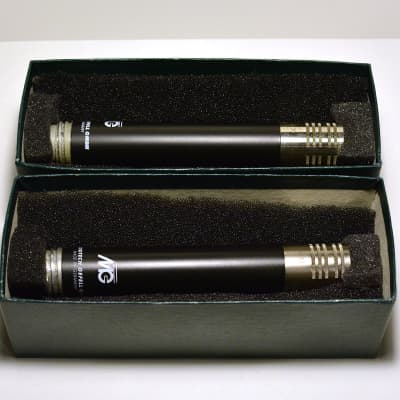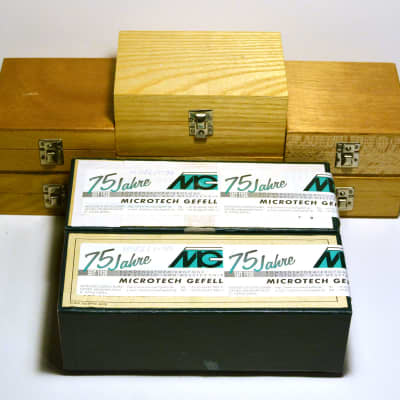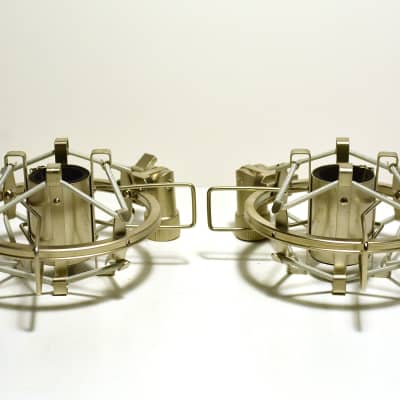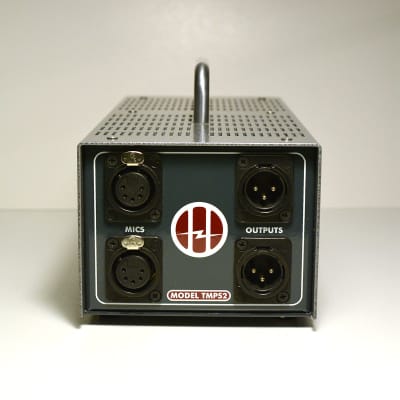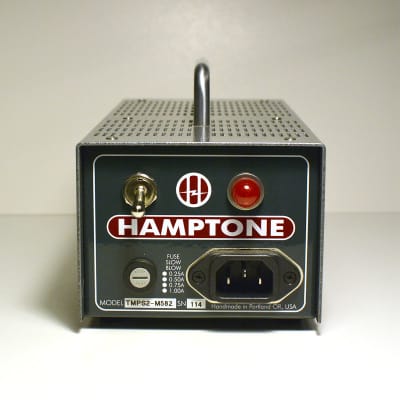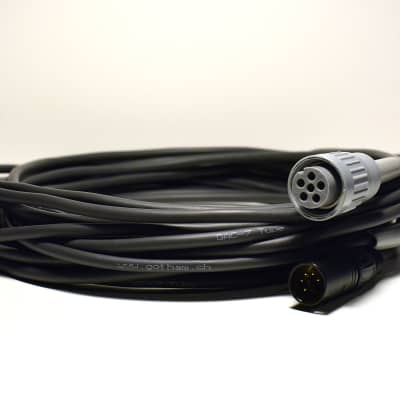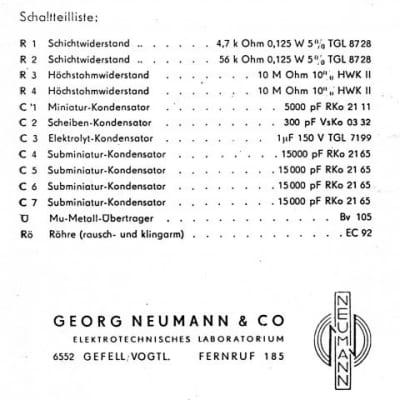Here is a really unique opportunity to acquire an ultimate pair of vintage Neumann M582 tube condenser microphones and set of capsules. The M582 had been a sleeper microphone for awhile, but they have become more widely recognized and revered in recent years. The threaded versions of the M582 are in higher demand and do not come up as often as the screw-on versions (which only work with the M62 cardioid capsule). It took years and some luck, but I was able to find matched sets of capsules (most with consecutive or nearly consecutive serial numbers).
This set contains pairs of the M71 cardioid capsule (with a large-membrane PVC diaphragm, like used in the M7 capsule), the M58 omni capsule (with a small-membrane PVC diaphragm), the M94 cardioid capsule (the threaded version of the M62 capsule, with a small-membrane Nickel-foil diaphragm, like used in the KM54 mic) and M70 cardioid capsules (with a small-membrane Nickel-foil diaphragm).
These M582 bodies will also work with any of the other threaded capsules including: the UM70 (the multi-patterned version of the M71 that switches between cardioid, omni and figure-8—although the figure-8 only works with MV69x mics), the M69 omni, the M93 (which essentially is just a M58 but released later), the M73 cardioid shotgun capsule and potentially a few others I have read about but have never seen. The other beauty of these capsules is that they also work with the solid-state version MV690, MV691 and MV692 preamp bodies (if you already have any of those or want to further expand your sonic palette down the road).
Overall with this microphone set you get a pair of high quality microphones (in Very Good/Excellent condition considering their age), that combine the warmth of the vintage tube circuitry with the superb detail of the range of finely manufactured capsules that cover just about anything you would want to use Small Diaphragm Condensers on (as well as a Large Diaphragm Condensers with the M71 capsules). It will cover more ground than most other pairs of microphones and will likely become your favorite choice for many applications.
This mic package also includes:
- The highest quality power supply, built by Hamptone, that really improves the sound over the original N58, N61 or others. The TMPS2 is a dual channel power supply that provides filament and plate voltage via two 5-pin gold XLR connectors and the output is via two 3-pin gold XLR connectors. It was just re-calibrated with this mic set at the end of November by Scott Hampton.
- Pair of 18 foot Gotham GA-7 microphone cables (7 Conductors), specially designed for tube microphones, with NOS Neumann NS-84 and Neutrik 5-pin gold XLR connectors put together for me by Redco Audio.
- Pair of after-market shock mounts designed by Peluso Microphone Lab.
- The original wooden boxes the capsules came with (except the M70s).
All of the capsules were carefully tested and matched by Thiersch in Germany (who worked for Neumann Berlin and Neumann Gefell between the 50’s-70’s). Both M94 capsules, M70 capsules and one of the M58 capsules were re-skinned by Thiersch, the premier technician in the world for this process. The re-skinned M58 was matched to the other M58 that did not need to be re-skinned and the pair of M71 were already well matched and did not need to be re-skinned either. The M582 bodies were checked out and refurbished by Gefell years ago and they were sent to another famous Neumann expert in the States (hence the Gefell boxes with the 70 year anniversary tape). They were working together to potentially re-release the microphones, but that never ended up happening, so the M582 bodies haven’t seen much use at all since then. In fact all the capsules have seen little use since coming back from Thiersch (and they were used with another pair of M582 I own). But these two M582 preamp bodies have been thoroughly tested with all the different capsules and everything is working well. I have not been doing much live tracking and so I hesitantly have decided to sell this ultimate matched set and just keep one of my M582 mics.
Note: - Gefell put the replacement black body covers on when they refurbished the M582 bodies, but if you would prefer original 60’s/70’s but non-matching body covers, let me know as I can maybe swap them with the other M582 I’m keeping and the other M582 I will also be selling in the future.
- My priority is to keep this matched set all together—but in case you already have a matched pair of one of the capsule types or only need three sets of capsules instead of all four, I may be willing to sell a slightly trimmed-down combination.
- For International Shipping, please contact me for a quote.
- In any of these cases above, or just in general, feel free to contact me if you have any questions.
More Info about M582 microphones and M71, M58, M94 and M70 CapsulesM582 Tube Preamp Body (threaded version)Type: Condenser MicrophoneTube: EC92 (or 6AB4)The M582 microphone body preamp (first released in 1958) is nearly the same as the CMV563 (first released in 1956), just in a smaller body (but uses the same PSU). The UM57 is also nearly the same (but that mic requires basically the same PSU except with added control to select the voltage to activate the remote pattern selection between Cardioid, Figure-8 and Omni). All three of those microphones use the EC92 tube or 6AB4 tube. Unlike the U47, with a similar overall circuit but uses the extremely rare VF14 tube instead, quality NOS EC92 and 6AB4 tubes can still be found for under $100 (versus literally thousands of dollars for a NOS VF14 tube if you can find one).
M-71 Capsule (a Cardioid only version of the Multi-Pattern UM70 capsule)Pattern: CardioidType: Large-Membrane (PVC), Pressure Gradient TransducerFrequency Response: 30 - 18,000 HzThe M71 capsules have the same brass backplate covered with a thin PVC diaphragm as used in the M7 capsule for CMV-563, CMV-3, UM-57 (and found in the early holy grail, and very expensive, U47 microphone). So when using this pair of microphones with the M71 capsules in stereo, or on two different sources, it is like having the rare opportunity to have a pair of CMV-563 (with the M7 or M7s capsules) or UM-57 (in cardioid mode) microphones. The M582/M71 combo, as a pair or by themselves, is amazing on vocals, drums, acoustic instruments and really just about any source. Bringing the detail, warmth and character that made Neumann one of the premier microphone brands.
M-94 Capsule (the threaded version of the M62 capsule)Pattern: Cardioid (Back absorption: 25 dB)Type: Small-Membrane(Nickel-foil), Pressure Gradient TransducerFrequency Response: 40 - 18,000 HzThe M94 capsule uses a nickel-foil membrane that is the same as used in the renowed and expensive KM54 (cardioid) and KM254 (cardioid) tube microphones. The membrane is extremely thin, at 0.7 microns (the thinnest Neumann ever made). Neumann manufactured these diaphragms via galvanization — Neumann engineers coated a sheet of copper foil with nickel, then dissolved the copper away to leave behind a nickel film. The capsule’s directional characteristic was created by the use of a “delay plate” or acoustical labyrinth, which delayed the sound entering the side and rear of the microphone slightly, so as to cancel out the same sounds hitting the front of the diaphragm. This design gave the mic 25dB of attenuation of off-axis sounds.
While both the KM54 and KM254 microphones use the AC-701 tube (which are not quite as rare as the VF14, a NOS AC-701 tube is well over $1000), and so they do not sound exactly the same as a M582 mic with a M94 capsule, their overall tonal characteristics are really similar. The same thin delicate capsule captures incredible detail with a lot of highs (about +5dB at 8khz)—but in a pleasing way, not harsh or piercing. The M582/M94 combo is an excellent choice especially for all the nuance of acoustic instruments, rich and musical, yet present mids and open top end. It is also very useful for many other applications, including room miking, strings, drums, backing vocal ensembles. For all those that have the M62 capsule with their non-threaded M582, this is the only combination they have available, but it is still a very useful and versatile combination.
M-58 Capsule (same as M-93)Pattern: OmniType: Small-Membrane (PVC), Pressure TransducerFrequency Response: 30 - 20,000 kHzAccording to Vintage King about a M582 with M58 capsule: “Many engineers consider this a great go-to mic for acoustic guitars, strings, vocal ensembles, drums, pianos, rooms and more. Omni mics such as these pick up the full sounding body of the instrument along with the room's 'air' and realism, providing depth and distance to your tracks. Great top end, with a musical, natural tone. The 582 (with a M58) can get close to an acoustic guitar without getting all the proximity effect. This is a nice-sounding alternative when one can't afford a Neumann KM53 or M50 omni mic. Useful on stereo rooms and most all omni mic applications.” The M58 has soft and detailed highs, bright in a very beautiful way—yet still big, smooth and lush overall. The M582/M58 combo can often bring more life and dimension to a source than a cardioid.
M-70 CapsulePattern: Cardioid (Back absorption: >20 dB)Type: Small-Membrane (Nickel-foil), Pressure Gradient TransducerFrequency Response: 50 - 16,000 HzThe M70 capsule also utilizes a nickel-foil membrane, but slightly different than the one used in the M94. The M70 is more linear with a slight bass roll off for close proximity mic'ing. Making it slightly more flat and neutral sounding than the other capsules, less hyped in the highs (perhaps halfway between a KM84 and vintage AKG 451E/EB in terms of brightness). The M582/M70 combo can be a little more of a utilitarian/safe/less-colored choice between the capsules, especially useful if you are worried the source may be a little too bright and harsh to begin with—like some cymbals, shakers, tambourines and acoustic instruments can be at times.
A Brief History of Neumann Microphones (East and West)Early YearsGeorg Neumann and Erich Rickmann establish the limited partnership Georg Neumann & Co in 1928. The Olympic Games in Berlin in 1936 provide the first live test for the classic M 7 electrode in a tube set-up as developed by Georg Neumann. The so-called “Neumann bottle” can already be equipped with different capsules in order to change patterns. In 1938 Erich Rickmann dies. Despite the heavy loss, Georg Neumann is able to continue leading the company to full extent and according to the ideas of is deceased co-partner - due to his close cooperation with manager Erich Kühnast ever since the founding days.
WWIIDuring the Second World War, the principal laboratory in Berlin undergoes damage both by fire and bombs. To avoid further bombings, the entire company and the principal laboratory are transferred to Gefell. Both the Neumann and Kühnast families, as well as almost all employees relocate to Gefell. In Gefell, production continues of the “Neumannbottle” CMV 3 using the large diaphragm capsule M 7 developed by Georg Neumann. The M 7 microphone capsule is also utilized in many other famous models developed by Neumann including:
- U 47, U 48, M 49
- CMV 563, UM 57, UM 70 capsule, M 71 capsule
Post WWIIUnbeknownst to Georg Neumann and Erich Kühnast, the town of Gefell would become part of the Soviet Union at the conclusion of World War II. Around this time Georg was invited by the French government to set up a lab in Paris, while Mr. Kühnast continued his work in Gefell. Some members of the original Neumann staff returned to their home city of Berlin and started a branch company which acted as a repair center for Neumann brand products in West Berlin. This "off shoot company" became the roots of a company which began in 1948, and was also known as "Neumann,” but more specifically Georg Neumann GmbH (versus Georg Neumann & Co in Gefell). Together with the rest of the staff, Erich Kühnast remains in Gefell. Georg Neumann assigns to him the management of the limited partnership Georg Neumann & Co. At first, the following products manufactured include:
- Condenser microphone CMV 4 with capsule M7 (cardioid) or 026/2 (omni)
- Condenser microphone CMV 5/B with the capsules M 7, M 8, M 9 and 026/2
- Microphone connector 6... NS 84/85 and NS 86/87
During the 1950s, radio stations in Germany are rebuilt and production in Gefell continues, both of the earlier microphone types and of new ones including:
- Tube microphone preamplifier CMV 563
- With the microphone capsules M 55 (omni), M 7 (cardioid), M 8 (figure eight) and M 9 (omni) as well as M 7 S, M 8 S and M 9 S with short handles
- Tube condenser microphone UM 57, switchable patterns, omni-cardioid-figure eight
- Tube microphone preamplifier M 582 with M 58 (omni)
The limited partnership Georg Neumann & Co. and Georg Neumann GmbH agree to equally use the Gefell trademark as created by Erich Kühnast. In order to distinguish both companies, Georg Neumann GmbH adds a diamond in the background while Georg Neumann & Co. uses a circle in the background.
Neumann "Berlin" and Neumann "Gefell" worked very closely together until 1961 when the wall was erected in Berlin that separated the West from the East. While key engineering staff worked at both facilities, the managements of the two companies stayed in contact (illegally as far as the Soviet authorities were concerned) and Georg Neumann also made regular visits to Gefell (until his passing in 1976). Before the separation the tube microphone preamplifier M 582 was developed along with the microphone capsule M 58 (omni) and was first released in 1958. After the separation the addition of the other capsule models including the M 62, M 70, M 71, M 94 continued through the 60’s and into the 70’s.
1970’s - PresentOn April 24th 1972 the limited partnership Georg Neumann & Co. in Gefell is expropriated and renamed VEB Mikrofontechnik Gefell. Further use of the Neumann trademark is prohibited by the Soviet Union. Instead, products are now marked with the brand RFT.
The first metal diaphragm microphones for precision recording were invented by the original company, Neumann Gefell, and continued to be manufactured throughout their history. Some of the more famous Neumann Berlin metal diaphragm microphone models have included the KM-54, KM-56 and SM-2 (and SM-23) stereo microphones, but the diaphragms for these microphones were not made in the Berlin factory. During the next 40 years Gefell accelerated the development of tube technology which as everyone knows, continued in eastern Europe while the west developed transistors.
In 1989, with the collapse of the Eastern Block and the subsequent fall of the Berlin Wall, Georg Neumann’s family saw the opportunity to regain their company in Gefell. By this time, the Berlin factory was in trouble. The company had expanded into other areas, which included disc cutting (vinyl) and custom console manufacturing, neither of which were sustainable businesses. In 1990, the Berliner Bank shut down the Georg Neumann GmbH Berlin factory, and arranged to sell the company to Sennheiser, who immediately moved what was left of the "diamond logo Neumann" you know today to the Sennheiser assembly line.
In 1993 'Georg Neumann & Company Gefell, GmbH' was given back to its original owners, the Neumann family. Ownership of the company today is retained by the directors of Microtech Gefell with the official name being 'Georg Neumann KG' (no relation to the Sennheiser Corporation's 'Neumann' brand name, a name which Sennheiser purchased in 1991 with the other assets of the bankrupt Neumann).
Microtech Gefell condenser microphones are manufactured using the original techniques and exclusive processes developed by Georg Neumann. The products they manufacture include the world's most accurate measurement microphone capsules, the world's only metal diaphragm microphones, and the venerable "M-7" capsule which saw it's rise to fame in Neumann Berlin manufactured models like the U-47, U-48 and M-49. The M-7 is the only large diaphragm microphone capsule to use PVC based diaphragms which sound much sweeter and more musical than the subsequent Mylar based KK-47 capsule found in later model U-47, U-48 and M-49 microphones. Just as they were originally, Microtech Gefell microphones are still hand built, individually tested and measured to ensure a quality level that is unsurpassed.

